Are you struggling with OAuth token expiration issues? Don’t worry, we’ve got you covered! Dealing with expired access tokens can be a hassle, but fear not, because we have the solution.
In this blog post, we will dive deep into the world of OAuth token expiration issues and explore effective ways to resolve them. Whether you’re a developer, a tech enthusiast, or simply curious about how to handle token expiration, this guide will provide you with the knowledge and confidence to tackle this challenge head-on. So, let’s get started and put those token expiration issues to rest!
Understanding OAuth Token Expiration
In the world of OAuth, token expiration is a common issue that many users encounter. Understanding how OAuth token expiration works is essential for resolving any related issues efficiently. In this section, we’ll dive into the role of refresh tokens, the expiration time, and access token validity.
The Role of Refresh Tokens
Refresh tokens play a crucial role in the OAuth flow. They are like a secret key that allows you to obtain a new access token when your current one expires. Think of refresh tokens as a lifeline, ensuring uninterrupted access to your favorite apps and services.
When your access token is about to expire, your application can use the refresh token to obtain a fresh access token without requiring the user to log in again. This seamless process allows you to continue using the application without any hassle.
Expiration Time
Every access token comes with an expiration time. This time limit acts as a security measure, ensuring that access to your data remains protected and secure. Once the expiration time is reached, the access token becomes invalid and cannot be used anymore.
The expiration time can vary depending on the OAuth provider and the specific API implementation. Some tokens may last for a few hours, while others can be valid for days or even weeks. It’s important to note that longer expiration times may pose a higher security risk if the token falls into the wrong hands.
Access Token Validity
The validity of an access token is determined by the OAuth provider. It is crucial to understand that the token validity period is not arbitrary; it is set to strike a balance between security and convenience.
It’s always a good practice to check the validity of your access token before making any API requests. This ensures that you are working with a valid token and avoids any potential errors or disruptions in the service.
Now that you have a better understanding of OAuth token expiration, you can navigate any related issues with confidence. Remember the importance of refresh tokens for obtaining new access tokens, keep an eye on the expiration time, and check the validity of your access tokens regularly.
For more information and detailed insights into OAuth token expiration, you can check out the resources below:
Handling OAuth Token Expiration Issues
When working with OAuth, it’s important to be prepared for token expiration issues. This can happen when the access token you received initially expires. Don’t worry, though, because there are ways to handle this situation effectively. Let’s explore these methods below.
Recognizing Expired Access Tokens
The first step in resolving token expiration issues is to recognize when an access token has expired. You can do this by examining the response received after making an API request. Look for a specific error message or check the WWW-Authenticate header, which may indicate an invalid_token error.
Making a Request to the Token Endpoint
Once you’ve identified that the access token has expired, you’ll need to make a request to the token endpoint. This endpoint allows you to obtain a new access token by using the refresh token you previously received. Make a POST request to the service’s token endpoint, including the necessary parameters such as grant_type=refresh_token, refresh_token, and the client credentials if required.
POST /oauth/token HTTP/1.1
Host: authorization-server.com
grant_type=refresh_token
&refresh_token=xxxxxxxxxxx
&client_id=xxxxxxxxxx
&client_secret=xxxxxxxxxx
Using the Refresh Token
When you make the request to the token endpoint, the refresh token comes into play. This token acts as a key to get a new access token. By including the refresh token in the request, the authorization server will respond with a fresh access token that you can use to retry the original API request.
Obtaining a New Access Token
After making the request to the token endpoint, you’ll receive a response containing a new access token. If you’re lucky, you may also receive a new refresh token. However, if no new refresh token is provided, it means that your existing refresh token will continue to work when the new access token expires.
It’s worth noting that the most secure option is for the authorization server to issue a new refresh token each time one is used. This prevents potential security risks, especially for clients without a client secret. The practice of issuing new refresh tokens is recommended in the latest Security Best Current Practice as it helps detect any stolen refresh tokens.
Dealing with OAuth token expiration issues can be perplexing, but by recognizing expiration signs, making requests to the token endpoint, utilizing the refresh token, and obtaining new access tokens, you can navigate these challenges smoothly. Stay ahead of the game and ensure seamless authentication for your users.
Remember to handle token expiration gracefully in your application and implement proper error handling to provide the best user experience.
Best Practices for Resolving OAuth Token Expiration Issues
If you’re facing OAuth token expiration issues, don’t worry! There are some best practices you can follow to resolve them effectively. Let’s explore these practices in more detail.
Implementing Refresh Token Rotation
One of the key practices to tackle OAuth token expiration is implementing refresh token rotation. This involves generating a new refresh token each time it’s used. By doing so, you enhance the security of your application and minimize the risk of token theft. Following the recommendation in the latest Security Best Current Practice, refreshing your refresh token helps prevent unauthorized access and ensures the continued smooth operation of your application.
Enhancing Security with Client Secrets
To further bolster the security of your OAuth implementation, it’s essential to use client secrets. Client secrets serve as the credentials for your application when interacting with the authentication server. They act as an additional layer of protection, ensuring that only authorized clients can access the requested resources. By securely managing and verifying client secrets, you add an extra level of security to your OAuth workflow.
Following Security Best Practices
In addition to refresh token rotation and the use of client secrets, it’s crucial to follow general security best practices. These practices include, but are not limited to, the following measures:
- Regularly auditing and monitoring access tokens and refresh tokens to detect any suspicious activities.
- Implementing strong encryption protocols to protect sensitive data during transit and storage.
- Enforcing strong password policies to prevent unauthorized access to user accounts.
- Regularly updating and patching your OAuth implementation to address any security vulnerabilities.
By adopting these security best practices, you can ensure the integrity and c






